A Novel Internet of Energy Based Optimal Multi-Agent Control Scheme for Microgrid including Renewable Energy Resources
Abstract
:1. Introduction
1.1. Related Works
- The critical bus voltage, subject to distributed secondary voltage regulation, must be restored to ensure continuous operation of sensitive loads. Literature [38] provides critical bus voltage restoration, but it doesn’t simultaneously maintain accurate reactive-power sharing among units of Renewable Energy Resources (RERs) [39].
- To the best of our knowledge, a behaviour and analysis of distributed secondary control, when the AC side voltage of a distributed generator unit reaches to its limit, has not been reported.
- The active power, reactive power-sharing simultaneous regulation are not investigated. Second, the distributed diffusion control method for multi agent governed microgrids in the Internet of Energy has not been studied. This motivates us to provide a novel approach that enables the group play and plug feature, such that microgrids with multiple multi agent, owned by different stakeholders, can be flexibly controlled.
1.2. Paper Contribution
- The peer-to-peer control architecture considering multi-agent and multi-layers interaction is introduced for a distribution networks in the Energy Internet, which has not been reported in the past.
- This paper summarises the findings of researchers in distributed control design of RERs devices in microgrid to provide ancillary services, including equal reactive power sharing, equal active power-sharing between RES units, and controlling the load in both islanded mode and grid-connected mode.
- An IoT-based communication protocol including specifications such as MQTT is proposed. This improves system flexibility. The proposed system offered analytics and business intelligence (BI), which allowed the researchers to gain insights on data collected by visualizing dashboards and reports. Additionally, the use of large data-based data storage technologies enabled the system’s scalability at the national level. This provided energy-efficiency strategies for the home owners and the utility companies.
2. Proposed System Description
- ThingSpeak Cloud IoT platform data aggregation, tracking and analysis. In the smart grid model, the power profile is monitored on multiple ThingSpeak channels in real-time and depicted graphically.
- Security: The Username and password allow user authentication while each channel is equipped with its ID and accessible (see by other users). There are two keys in each channel for the application programming interface. A randomly generated read key and write key of the API. These keys can save or retrieve information from each channel over the Internet or LAN.
- It facilitates the double-way flow of data between the user and virtual device and allows data and remote control to be exchanged in real-time. The MATLAB Desktop Toolbox offers communication between the simulated feeding model and the ThingSpeak IoT platform.
- Communication network enabling for the data transmission over the Internet between MATLAB and ThingSpeak.
- Allows importing, exporting, analysing, and viewing data on multiple platforms and their fields simultaneously,
3. Renewable Energy Resources (RERs)
3.1. Photovoltaic Cell Modeling
3.2. Photovoltaic Modeling
System of Energy Storage
3.3. Diesel Generator of Disterbuted Network
3.4. Problem Formulation
3.5. Primary Control of Inverter
3.6. MASs Communication
3.7. Proposed Secondary Distributed Controller
4. Proposed Internet of Energy Communication Platform
- (a)
- Agent Layer
- (b)
- IoT platform layer
- (c)
- Network layer
- (d)
- Layer of data processing
- (e)
- Layer of cloud
4.1. MQTT Knowledge
4.2. Architecture of Proposed System
5. Result Analysis and Discussion Proposed Method
6. Access to Internet Web Page
7. Results Discussion
- In both scenarios, as Figure 12 illustrates, the aims of active power sharing can be accurately achieved.
- From Figure 13, the suggested system can realise accurate sharing of reactive power. As the control objective of power sharing is to make sure both reactive and active power sharing among generators follows renewable energy resources,
8. Conclusions
Author Contributions
Funding
Institutional Review Board Statement
Informed Consent Statement
Data Availability Statement
Conflicts of Interest
Nomenclature
| Renewable Energy Resources | RERs |
| Networked Renewable Energy Resources | NRERs |
| Peer-To-Peer | P2P |
| Internet of Things | IoT |
| Internet Protocol | IP |
| Transmission Control Protocol | TCP |
| Message Queuing Telemetry Transport | MQTT |
| Renewable Energy Technologies | RET |
| Distributed Energy Resources | DER |
| Multi Agent Systems | MAS |
| Internet Of Energy | IoE |
| Alternating Current | AC |
| Microgrid | MG |
| Direct Current | DC |
| Low Voltage | LV |
| Business Intelligence | BI |
| Local Area Network | LAN |
| Measurement Units | MU |
| Identity Document | ID |
| Application Programming Interface | API |
| Photovoltaic | PV |
References
- Kumar, M. Social, Economic, and Environmental Impacts of Renewable Energy Resources. In Wind Solar Hybrid Renewable Energy System; Okedu, K.E., Tahour, A., Aissaou, A.G., Eds.; IntechOpen: London, UK, 2020. [Google Scholar] [CrossRef] [Green Version]
- Liu, X.; Su, B. Microgrids—An integration of renewable energy technologies. In Proceedings of the 2008 China International Conference on Electricity Distribution, Guangzhou, China, 10–13 December 2018. [Google Scholar] [CrossRef]
- Alhasnawi, B.N.; Jasim, B.H. A New Coordinated Control of Hybrid Microgrids with Renewable Energy Resources under Variable Loads and Generation Conditions. Iraqi J. Electr. Electron. Eng. 2020, 16, 1–20. [Google Scholar] [CrossRef]
- Perez-Ibacache, R.; Silva, C.A.; Yazdani, A. Linear state-feedback primary control for enhanced dynamic response of AC microgrids. IEEE Trans. Smart Grid 2019, 10, 3149–3161. [Google Scholar] [CrossRef]
- Alhasnawi, B.N.; Jasim, B.H.; Anvari-Moghaddam, A.; Blaabjerg, F. A New Robust Control Strategy for Parallel Operated Inverters in Green Energy Applications. Energies 2020, 13, 3480. [Google Scholar] [CrossRef]
- Cucuzzella, M.; Incremona, G.P.; Ferrara, A. Decentralized sliding mode control of islanded AC microgrids with arbitrary topology. IEEE Trans. Ind. Electron. 2017, 64, 6706–6713. [Google Scholar] [CrossRef] [Green Version]
- Hu, J.; Bhowmick, P. A consensus-based robust secondary voltage and frequency control scheme for islanded microgrids. Int. J. Electr. Power Energy Syst. 2020, 116, 105575. [Google Scholar] [CrossRef]
- Alhasnawi, B.N.; Jasim, B.H.; Esteban, M.D. A New Robust Energy Management and Control Strategy for a Hybrid Microgrid System Based on Green Energy. Sustain. J. Rec. 2020, 12, 5724. [Google Scholar] [CrossRef]
- Seyedi, Y.; Karimi, H.; Guerrero, J.M. Centralized disturbance detection in smart microgrids with noisy and intermittent synchrophasor data. IEEE Trans. Smart Grid 2017, 8, 2775–2783. [Google Scholar] [CrossRef] [Green Version]
- Garcia-Trivino, P.; Torreglosa, J.P.; Fernandez-Ramirez, L.M.; Jurado, F. Decentralized fuzzy logic control of microgrid for electric vehicle charging station. IEEE J. Emerg. Sel. Power Electron. 2018, 6, 726–737. [Google Scholar] [CrossRef]
- Alhasnawi, B.N.; Jasim, B.H.; Sedhom, B.E.; Hossain, E.; Guerrero, J.M. A New Decentralized Control Strategy of Microgrids in the Internet of Energy Paradigm. Energies 2021, 14, 2183. [Google Scholar] [CrossRef]
- Lu, X.; Chen, S.; Lü, J. Finite-time tracking for double integrator multiagent systems with bounded control input. IET Control Theory Appl. 2013, 7, 1562–1573. [Google Scholar] [CrossRef]
- Bidram, A.; Lewis, F.L.; Davoudi, A. Distributed control systems for small-scale power networks: Using multiagent cooperative control theory. IEEE Control Syst. Mag. 2014, 34, 5677. [Google Scholar]
- Wang, Y.; Nguyen, T.L.; Syed, M.H.; Xu, Y.; Guillo-Sansano, E.; Nguyen, V.-H.; Burt, G.M.; Tran, Q.-T.; Caire, R. A Distrib-uted Control Scheme of Microgrids in Energy Internet Paradigm and Its Multisite Implementation. IEEE Trans. Ind. Inform. 2021, 17, 1141–1153. [Google Scholar] [CrossRef] [Green Version]
- Hou, X.; Sun, Y.; Lu, J.; Zhang, X.; Koh, L.H.; Su, M.; Guerrero, J.M. Distributed Hierarchical Control of AC Microgrid Oper-ating in Grid-Connected, Islanded and Their Transition Modes. IEEE Access 2018, 6, 77388–77401. [Google Scholar] [CrossRef]
- Shafiee, Q.; Guerrero, J.M.; Vasquez, J.C. Distributed Secondary Control for Islanded Microgrids—A Novel Approach. IEEE Trans. Power Electron. 2014, 29, 1018–1031. [Google Scholar] [CrossRef] [Green Version]
- Zhang, C.; Xu, Y.; Dong, Z.Y.; Yang, L.F. Multitimescale Coordinated Adaptive Robust Operation for Industrial Multienergy Microgrids with Load Allocation. IEEE Trans. Ind. Inform. 2019, 16, 3051–3063. [Google Scholar] [CrossRef]
- Molzahn, D.K.; Dorfler, F.; Sandberg, H.; Low, S.H.; Chakrabarti, S.; Baldick, R.; Lavaei, J. A Survey of Distributed Optimi-zation and Control Algorithms for Electric Power Systems. IEEE Trans. Smart Grid 2017, 8, 2941–2962. [Google Scholar] [CrossRef]
- Wang, Y.; Xu, Y.; Tang, Y.; Syed, M.H.; Guillo-Sansano, E.; Burt, G.M. Decentralised-distributed hybrid voltage regulation of power distribution networks based on power inverters. IET Gener. Transm. Distrib. 2019, 13, 444–451. [Google Scholar] [CrossRef]
- Ge, X.; Yang, F.; Han, Q.-L. Distributed networked control systems: A brief overview. Inf. Sci. 2017, 380, 117–131. [Google Scholar] [CrossRef]
- Eskandari, M.; Li, L.; Moradi, M.H.; Siano, P.; Blaabjerg, F. Active Power Sharing and Frequency Restoration in an Autonomous Networked Microgrid. IEEE Trans. Power Syst. 2019, 34, 4706–4717. [Google Scholar] [CrossRef]
- Awal, M.A.; Yu, H.; Tu, H.; Lukic, S.M.; Husain, I. Hierarchical Control for Virtual Oscillator Based Grid-Connected and Islanded Microgrids. IEEE Trans. Power Electron. 2020, 35, 988–1001. [Google Scholar] [CrossRef]
- Weng, S.; Yue, D.; Dou, C.; Shi, J.; Huang, C. Distributed Event-Triggered Cooperative Control for Frequency and Voltage Stability and Power Sharing in Isolated Inverter-Based Microgrid. IEEE Trans. Cybern. 2019, 49, 1427–1439. [Google Scholar] [CrossRef] [PubMed]
- Ding, L.; Han, Q.-L.; Zhang, X.-M. Distributed Secondary Control for Active Power Sharing and Frequency Regulation in Islanded Microgrids Using an Event-Triggered Communication Mechanism. IEEE Trans. Ind. Inform. 2019, 15, 3910–3922. [Google Scholar] [CrossRef]
- Mortezaei, A.; Simoes, M.G.; Savaghebi, M.; Guerrero, J.M.; Al-Durra, A. Cooperative Control of Multi-Master–Slave Islanded Microgrid With Power Quality Enhancement Based on Conservative Power Theory. IEEE Trans. Smart Grid 2016, 9, 2964–2975. [Google Scholar] [CrossRef] [Green Version]
- Diaz, N.L.; Luna, A.C.; Vasquez, J.C.; Guerrero, J.M. Centralized Control Architecture for Coordination of Distributed Renewable Generation and Energy Storage in Islanded AC Microgrids. IEEE Trans. Power Electron. 2017, 32, 5202–5213. [Google Scholar] [CrossRef] [Green Version]
- Alhasnawi, B.N.; Jasim, B.H. A Novel Hierarchical Energy Management System Based on Optimization for Multi-Microgrid. Int. J. Electr. Eng. Inform. 2020, 12, 586–606. [Google Scholar]
- Liu, X.-K.; Jiang, H.; Wang, Y.-W.; He, H. A Distributed Iterative Learning Framework for DC Microgrids: Current Sharing and Voltage Regulation. IEEE Trans. Emerg. Top. Comput. Intell. 2018, 4, 119–129. [Google Scholar] [CrossRef]
- Coelho, E.A.A.; Wu, D.; Guerrero, J.M.; Vasquez, J.C.; Dragicevic, T.; Stefanovic, C.; Popovski, P. Small-Signal Analysis of the Microgrid Secondary Control Considering a Communication Time Delay. IEEE Trans. Ind. Electron. 2016, 63, 6257–6269. [Google Scholar] [CrossRef] [Green Version]
- Zhang, R.; Hredzak, B. Distributed Finite-Time Multiagent Control for DC Microgrids with Time Delays. IEEE Trans. Smart Grid 2019, 10, 2692–2701. [Google Scholar] [CrossRef]
- Alhasnawi, B.N.; Jasim, B.H. A New Energy Management System Of On-Grid / Off-Grid Using Adaptive Neuro-Fuzzy Inference System. J. Eng. Sci. Technol. 2020, 15, 3903–3919. [Google Scholar]
- Shahab, M.A.; Mozafari, B.; Soleymani, S.; Dehkordi, N.M.; Shourkaei, H.M.; Guerrero, J.M. Distributed Consensus-Based Fault Tolerant Control of Islanded Microgrids. IEEE Trans. Smart Grid 2020, 11, 37–47. [Google Scholar] [CrossRef]
- Yoo, H.-J.; Nguyen, T.-T.; Kim, H.-M. Consensus-Based Distributed Coordination Control of Hybrid AC/DC Microgrids. IEEE Trans. Sustain. Energy 2020, 11, 629–639. [Google Scholar] [CrossRef]
- Wu, X.; Xu, Y.; He, J.; Wang, X.; Vasquez, J.C.; Guerrero, J.M. Pinning-Based Hierarchical and Distributed Cooperative Control for AC Microgrid Clusters. IEEE Trans. Power Electron. 2020, 35, 9865–9885. [Google Scholar] [CrossRef]
- Alhasnawi, B.N.; Jasim, B.H.; Rahman ZA, S.; Siano, P. A Novel Robust Smart Energy Management and Demand Reduction for Smart Homes Based on Internet of Energy. Sensors 2021, 21, 4756. [Google Scholar] [CrossRef]
- Alhasnawi, B.N.; Jasim, B.H.; Siano, P.; Guerrero, J.M. A Novel Real-Time Electricity Scheduling for Home Energy Management System Using the Internet of Energy. Energies 2021, 14, 3191. [Google Scholar] [CrossRef]
- Wang, Y.; Nguyen, T.-L.; Xu, Y.; Tran, Q.-T.; Caire, R. Peer-to-Peer Control for Networked Microgrids: Multi-Layer and Multi-Agent Architecture Design. IEEE Trans. Smart Grid 2020, 11, 4688–4699. [Google Scholar] [CrossRef]
- Bidram, A.; Davoudi, A.; Lewis, F.L. A multiobjective distributed control framework for islanded AC microgrids. IEEE Trans. Ind. Informat. 2014, 10, 1785–1798. [Google Scholar] [CrossRef]
- Simpson-Porco, J.W.; Shafiee, Q.; Dörfler, F.; Vasquez, J.C.; Guerrero, J.M.; Bullo, F. Secondary frequency and voltage control of islanded microgrids via distributed averaging. IEEE Trans. Ind. Electron. 2015, 62, 7025–7038. [Google Scholar] [CrossRef]
- Wu, X.; Shen, C.; Iravani, R. A Distributed, Cooperative Frequency and Voltage Control for Microgrids. IEEE Trans. Smart Grid 2018, 9, 2764–2776. [Google Scholar] [CrossRef]
- Schiffer, J.; Seel, T.; Raisch, J.; Sezi, T. Voltage stability and reactive power sharing in inverter-based microgrids with consensus-based distributed voltage control. IEEE Trans. Control Syst. Technol. 2016, 24, 96–109. [Google Scholar] [CrossRef] [Green Version]
- Simpson-Porco, J.W.; Dörfler, F.; Bullo, F. Synchronization and power sharing for droop-controlled inverters in islanded microgrids. Automatica 2013, 49, 2603–2611. [Google Scholar] [CrossRef] [Green Version]
- Forcan, M.; Maksimović, M. Cloud-Fog-based approach for Smart Grid monitoring. Simul. Model. Pract. Theory 2020, 101, 101988. [Google Scholar] [CrossRef]
- Ortiz, L.; Orizondo, R.; Águila, A.; González, J.W.; López, G.J.; Isaac, I. Hybrid AC/DC microgrid test system simulation: Grid-connected mode. Heliyon 2019, 5, 12. [Google Scholar] [CrossRef] [PubMed] [Green Version]
- Alhasnawi, B.N.; Jasim, B.H. Adaptive Energy Management System for Smart Hybrid Microgrids. In Proceedings of the 3rd Scientific Conference of Electrical and Electronic Engineering Researches (SCEEER), Basrah, Iraq, 15–16 June 2020. [Google Scholar] [CrossRef]
- Alhasnawi, B.N.; Jasim, B.H.; Issa, W.; Esteban, M.D. A Novel Cooperative Controller for Inverters of Smart Hybrid AC/DC Microgrids. Appl. Sci. 2020, 10, 6120. [Google Scholar] [CrossRef]
- Qiu, H.; Zhao, B.; Gu, W.; Bo, R. Bi-Level Two-Stage Robust Optimal Scheduling for AC/DC Hybrid Multi-Microgrids. IEEE Trans. Smart Grid 2018, 9, 5455–5466. [Google Scholar] [CrossRef]
- Xu, Y.; Sun, H.; Gu, W.; Xu, Y.; Li, Z. Optimal Distributed Control for Secondary Frequency and Voltage Regulation in an Islanded Microgrid. IEEE Trans. Ind. Inform. 2019, 15, 225–235. [Google Scholar] [CrossRef]
- Kyprianidis, K.; Dahlquist, E. (Eds.) Consensus Control of Distributed Battery Energy Storage Devices in Smart Grids. In AI and Learning Systems—Industrial Applications and Future Directions, Konstantinos Kyprianidis and Erik Dahlquist; IntechOpen: London, UK, 2021. [Google Scholar] [CrossRef]
- Tajalli, S.Z.; Mardaneh, M.; Taherian-Fard, E.; Izadian, A.; Kavousi-Fard, A.; Dabbaghjamanesh, M.; Niknam, T. DoS-Resilient Distributed Optimal Sched-uling in a Fog Supporting IIoT-Based Smart Microgrid. IEEE Trans. Ind. Appl. 2020, 56, 2968–2977. [Google Scholar] [CrossRef]
- Alhasnawi, B.N.; Jasim, B.H. A new internet of things enabled trust distributed demand side management system. Sustain. Energy Technol. Assess. 2021, 46, 101272. [Google Scholar]
- Marzal, S.; González-Medina, R.; Salas-Puente, R.; Garcerá, G.; Figueres, E. An Embedded Internet of Energy Communication Platform for the Future Smart Microgrids Man-age-ment. IEEE Internet Things J. 2019, 6, 7241–7252. [Google Scholar] [CrossRef] [Green Version]
- Alhasnawi, B.N.; Jasim, B.H.; Esteban, M.D.; Guerrero, J.M. A Novel Smart Energy Management as a Service over a Cloud Computing Platform for Nanogrid Appliances. Sustain. J. Rec. 2020, 12, 9686. [Google Scholar] [CrossRef]
- Guo, Z.; Pinson, P.; Chen, S.; Yang, Q.; Yang, Z. Chance-Constrained Peer-to-Peer Joint Energy and Reserve Market Considering Renewable Generation Uncertainty. IEEE Trans. Smart Grid 2021, 12, 798–809. [Google Scholar] [CrossRef]
- Song, Y.; Hill, D.J.; Liu, T. Small-Disturbance Angle Stability Analysis of Microgrids: A Graph Theory Viewpoint. IEEE Conf. Control. Appl. 2015. [Google Scholar] [CrossRef]


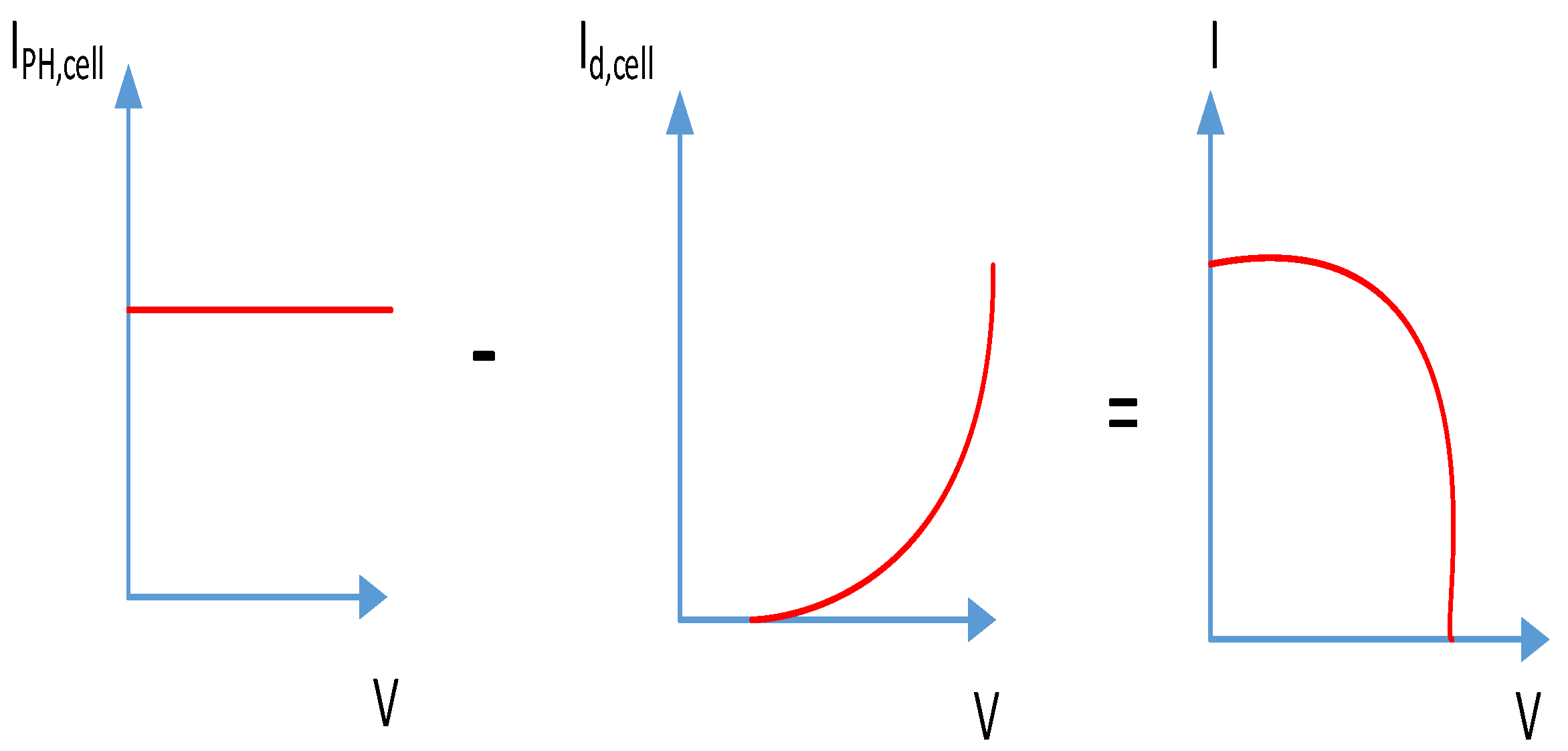
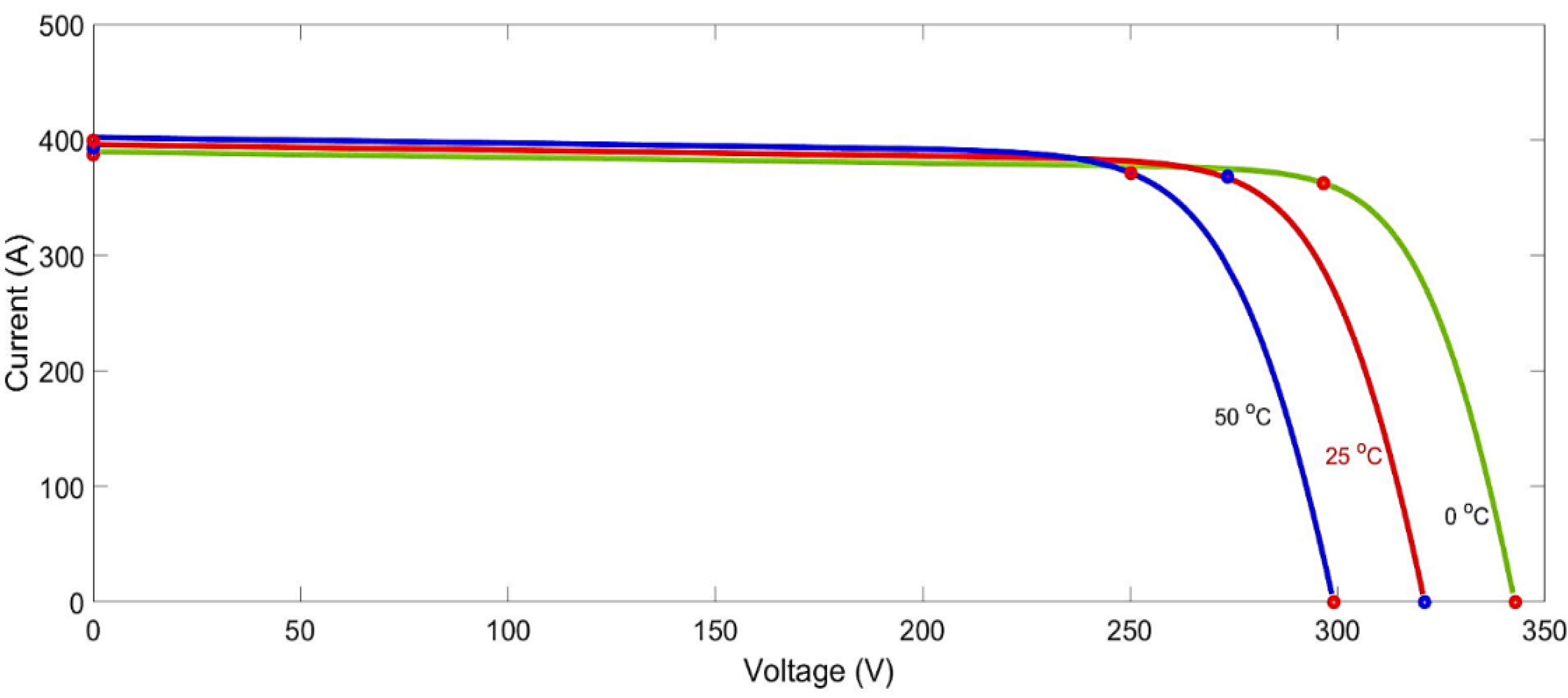
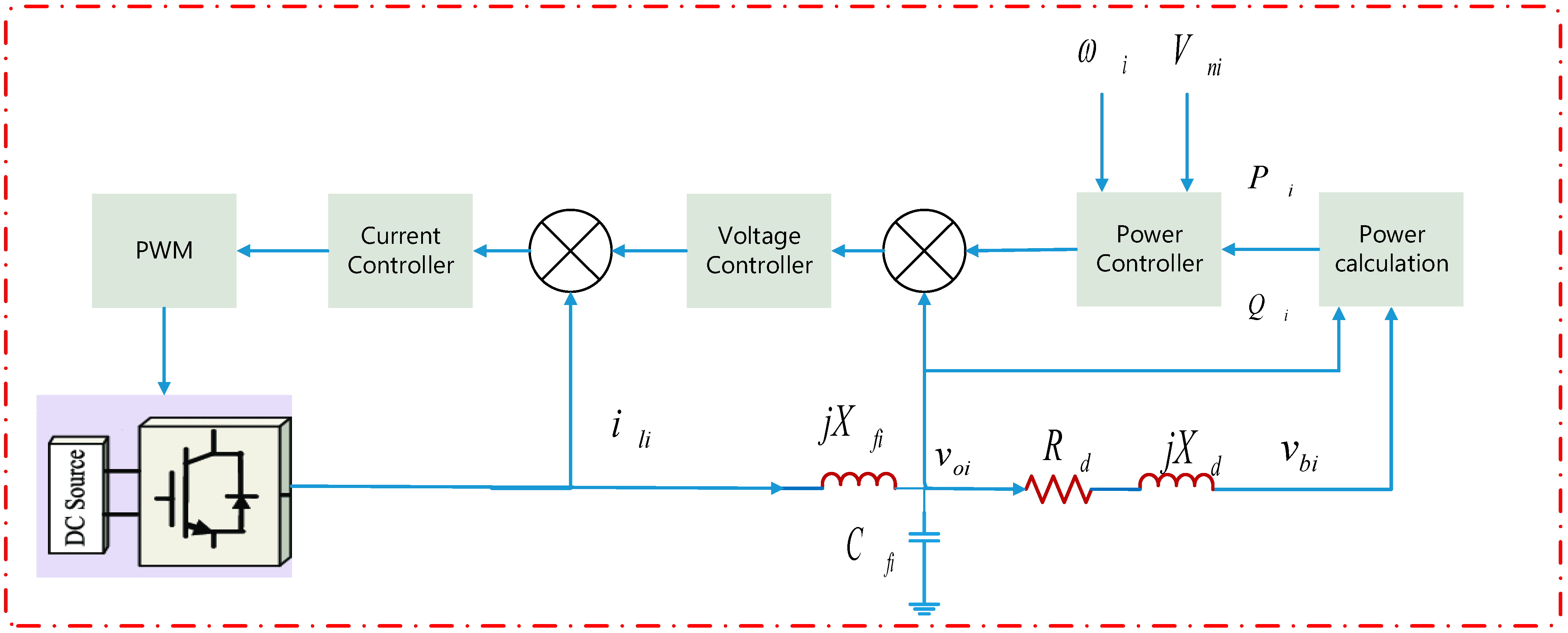

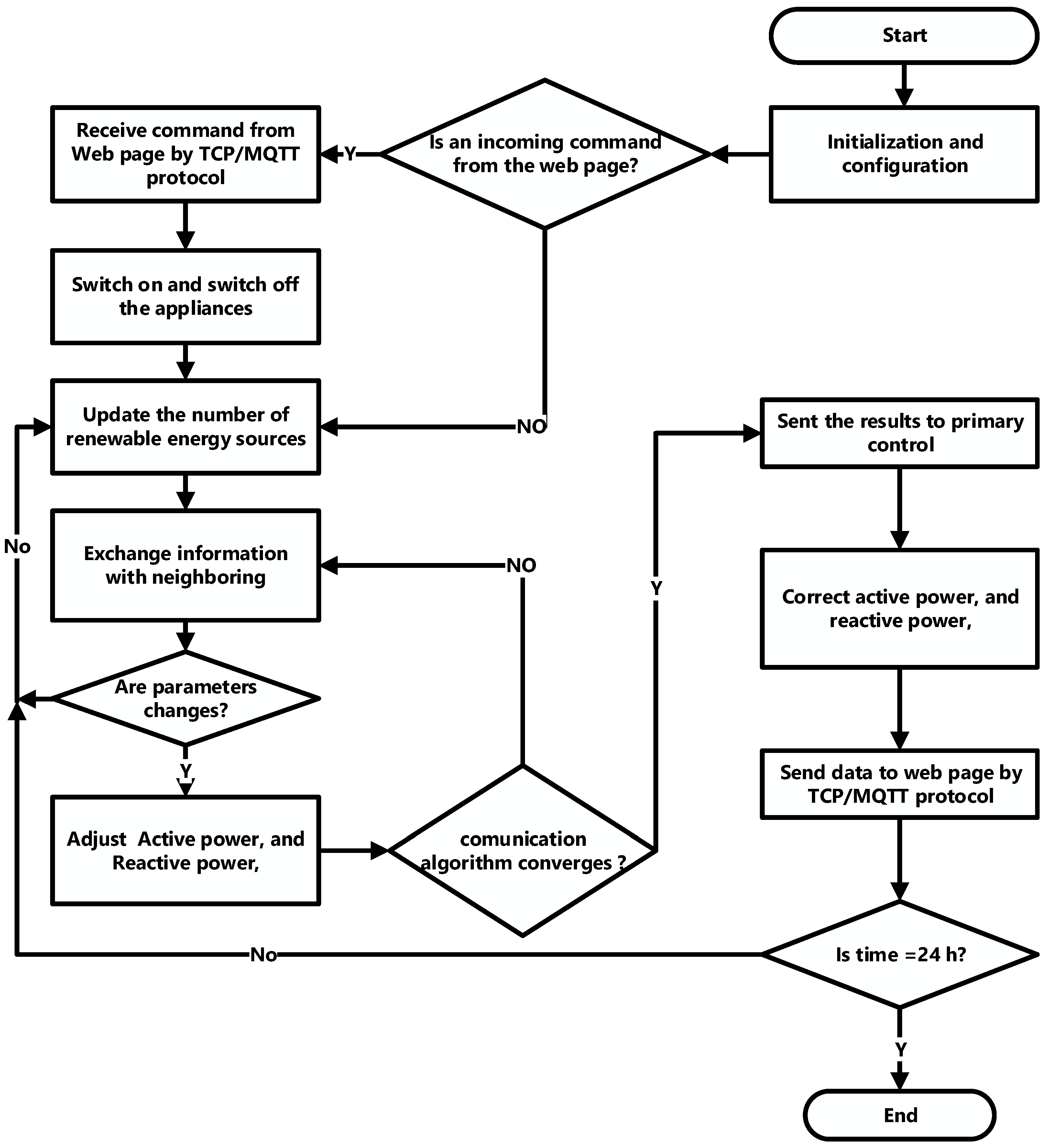
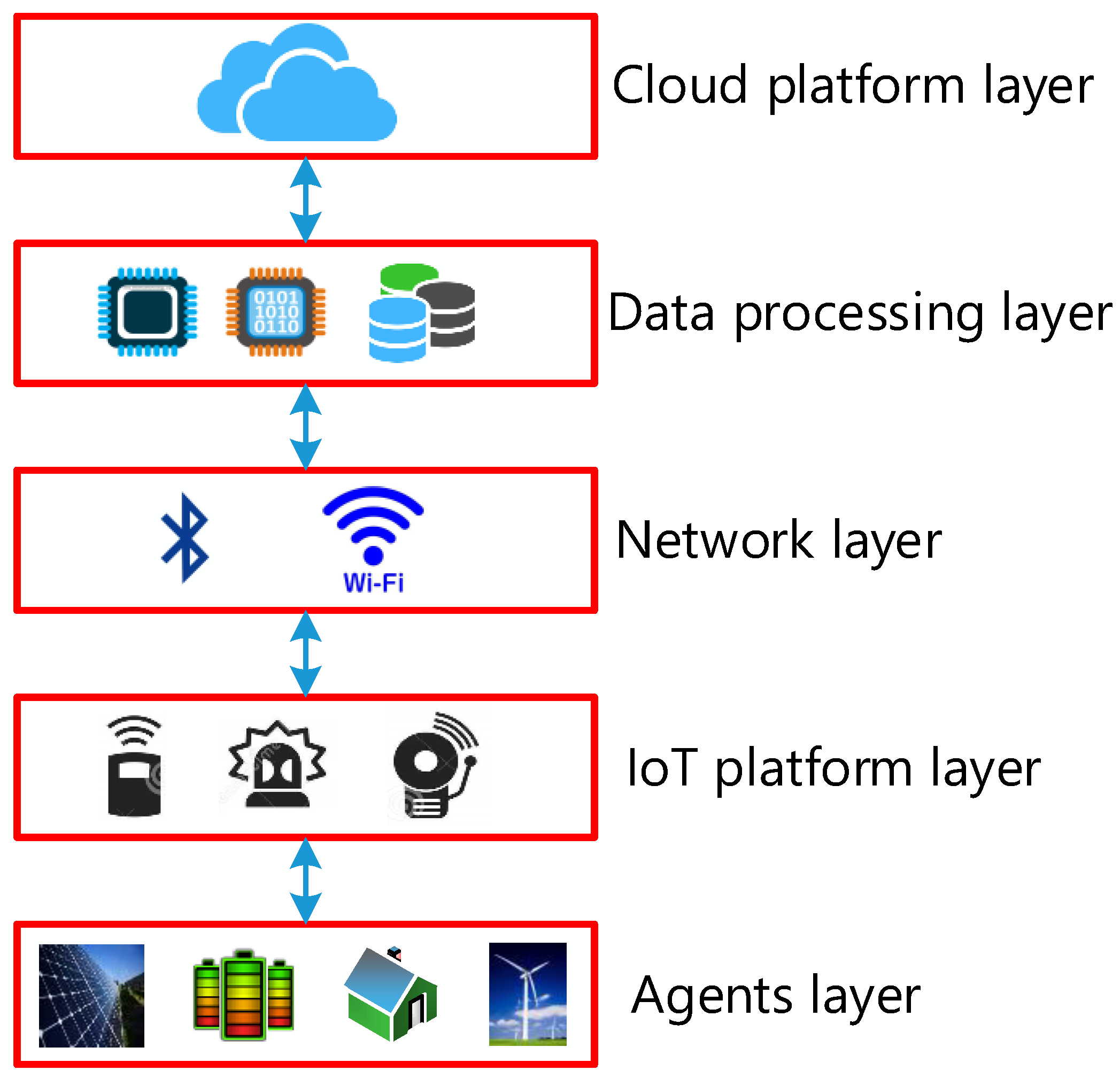




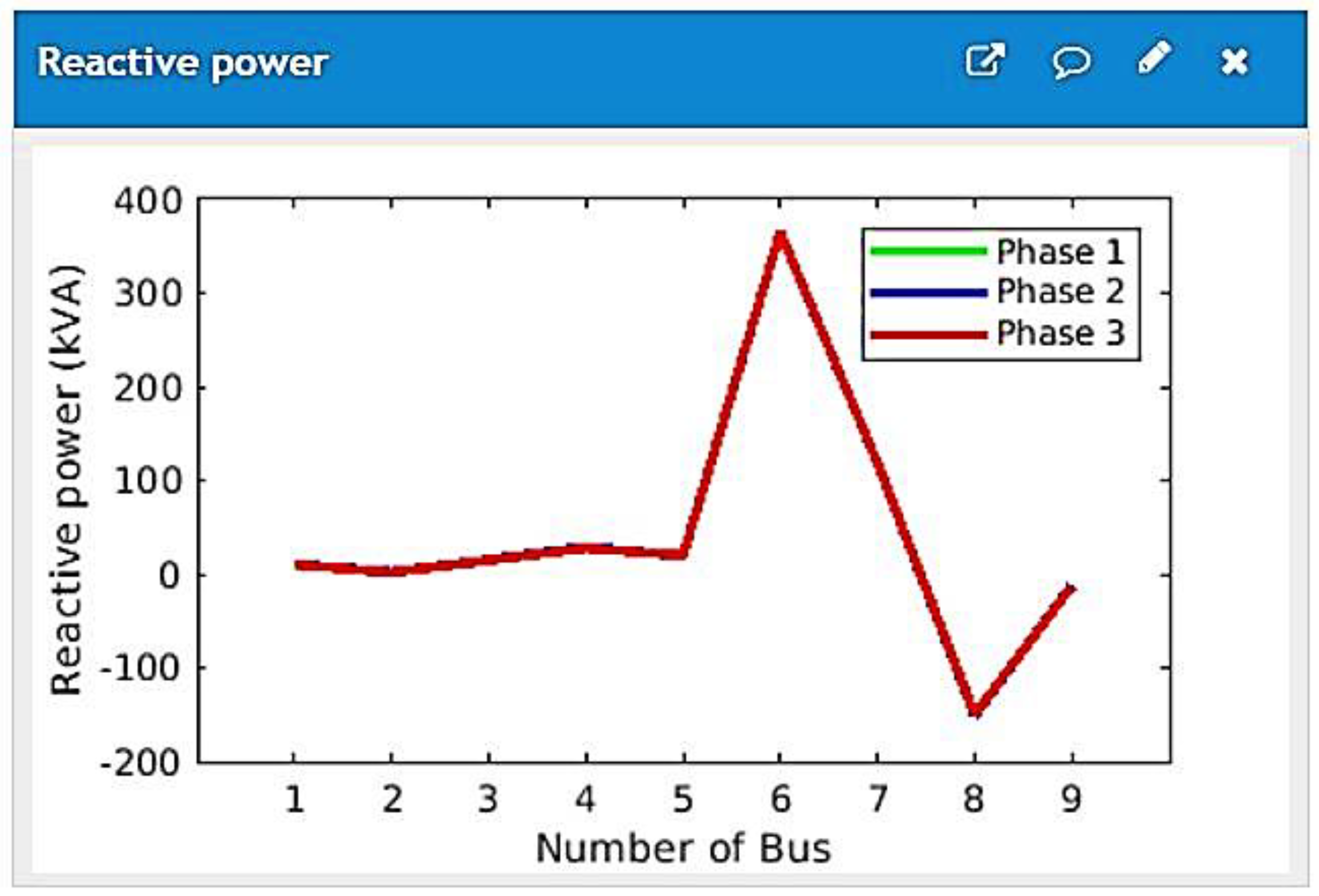


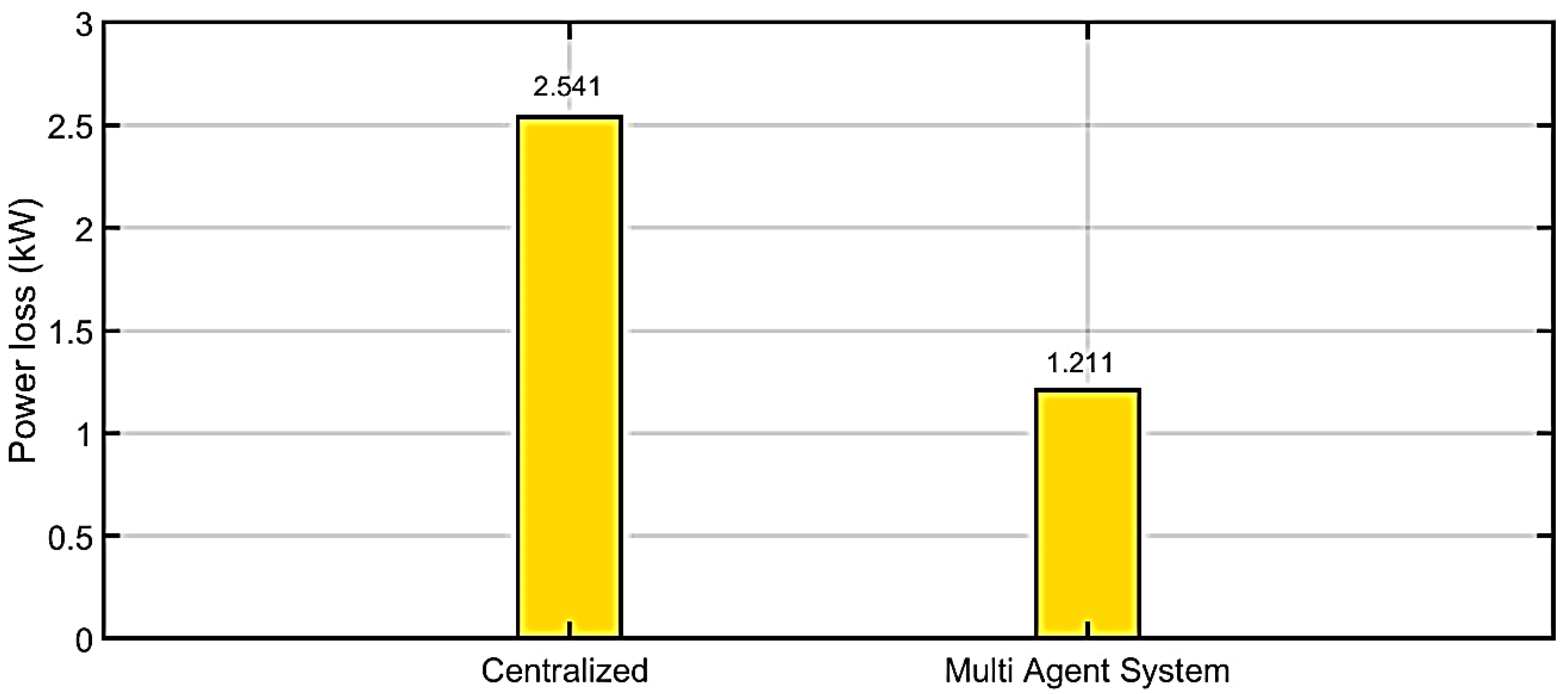
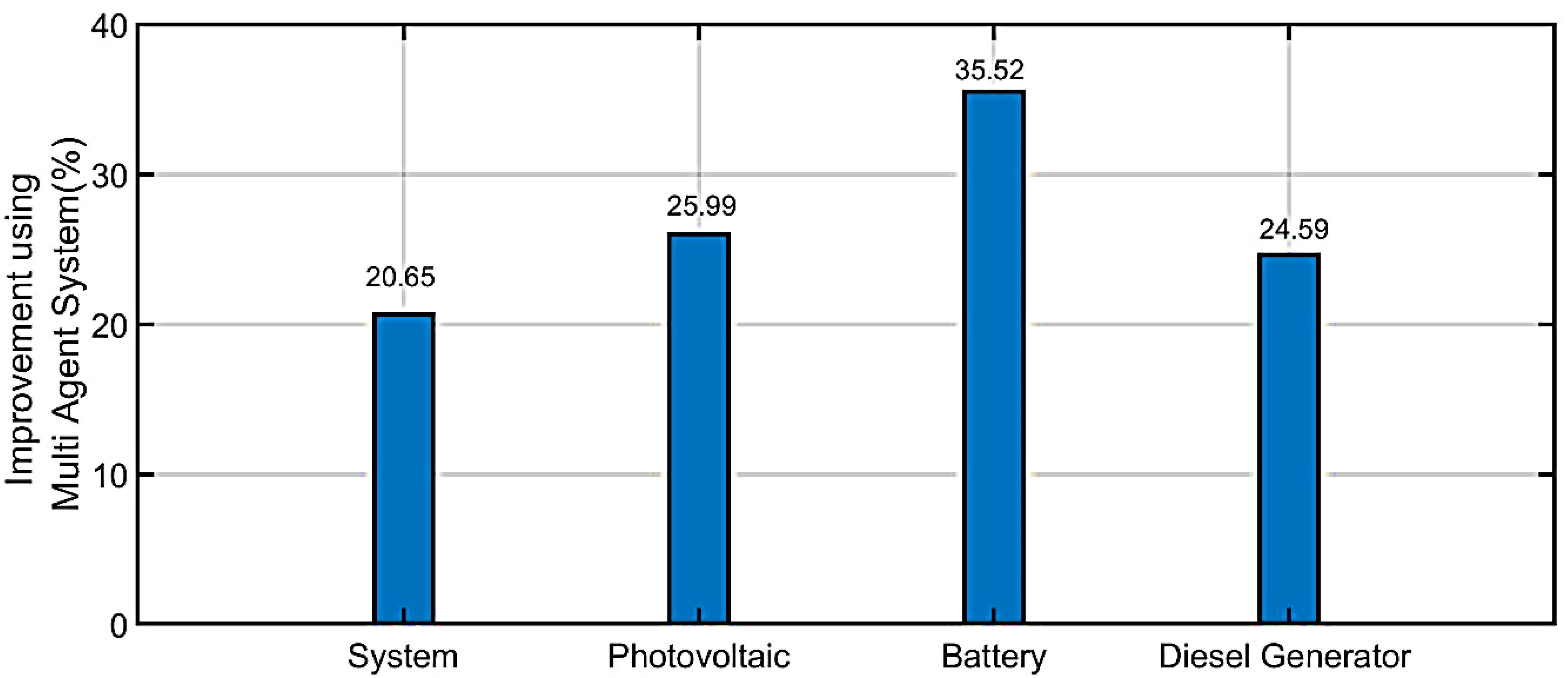
| Parameters | Values |
|---|---|
| Short-circuit current | 5.96 (A) |
| Parallel string | |
| Maximum current | 5.58 (A) |
| Maximum voltage | 54.7 (V) |
| Temperature coefficient of | −0.27269 (%/°C) |
| Temperature coefficient of | 0.061745 (%/°C) |
| Shunt resistance | 269.5934 Ω |
| Series resistance | 0.37152 Ω |
| Diode saturation curent | (A) |
| Series connected modules | |
| Short-circuit current | 6.42 (V) |
| Number of cells | 96 |
| Bus | |||||
|---|---|---|---|---|---|
| 1 | 0.67 | 0 | 1 | 5 | 0 |
| 2 | 1.63 | 0 | 1 | 5 | 0 |
| 3 | 0.85 | 0 | 1 | 5 | 0 |
| 4 | 0 | 0 | 1 | 0 | |
| 5 | 0 | 0.9 | 1 | 0 | 2 |
| 6 | 0 | 0 | 1 | 0 | |
| 7 | 0 | 1 | 1 | 0 | 2 |
| 8 | 0 | 0 | 1 | 0 | |
| 9 | 0 | 1.25 | 1 | 0 | 2 |
| Efficiency and Effectiveness | Proposed Method | Centralized | Percentage Improvement with Proposed System (%) |
|---|---|---|---|
| 0.771 | 0.639 | 20.65% | |
| 0.853 | 0.677 | 25.99 | |
| 0.885 | 0.653 | 35.52 | |
| 0.856 | 0.687 | 24.59 | |
| 1.211 | 2.541 | 52.34% |
Publisher’s Note: MDPI stays neutral with regard to jurisdictional claims in published maps and institutional affiliations. |
© 2021 by the authors. Licensee MDPI, Basel, Switzerland. This article is an open access article distributed under the terms and conditions of the Creative Commons Attribution (CC BY) license (https://creativecommons.org/licenses/by/4.0/).
Share and Cite
Alhasnawi, B.N.; Jasim, B.H.; Rahman, Z.-A.S.A.; Guerrero, J.M.; Esteban, M.D. A Novel Internet of Energy Based Optimal Multi-Agent Control Scheme for Microgrid including Renewable Energy Resources. Int. J. Environ. Res. Public Health 2021, 18, 8146. https://doi.org/10.3390/ijerph18158146
Alhasnawi BN, Jasim BH, Rahman Z-ASA, Guerrero JM, Esteban MD. A Novel Internet of Energy Based Optimal Multi-Agent Control Scheme for Microgrid including Renewable Energy Resources. International Journal of Environmental Research and Public Health. 2021; 18(15):8146. https://doi.org/10.3390/ijerph18158146
Chicago/Turabian StyleAlhasnawi, Bilal Naji, Basil H. Jasim, Zain-Aldeen S. A. Rahman, Josep M. Guerrero, and M. Dolores Esteban. 2021. "A Novel Internet of Energy Based Optimal Multi-Agent Control Scheme for Microgrid including Renewable Energy Resources" International Journal of Environmental Research and Public Health 18, no. 15: 8146. https://doi.org/10.3390/ijerph18158146









